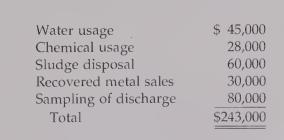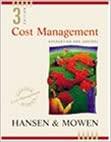Lewis Company produces jewelry that requires electroplating with gold, silver, and other valuable metals. Electroplating uses large
Question:
Lewis Company produces jewelry that requires electroplating with gold, silver, and other valuable metals. Electroplating uses large amounts of water and chemicals, producing wastewater with a number of toxic residuals. Currently Lewis uses settlement tanks to remove waste; unfortunately, the approach is inefficient and much of the toxic residue is left in the water that is discharged into a local river. The amount of toxic discharge exceeds the legal, allowable amounts, and the company is faced with substantial, ongoing environmental fines.
The environmental violations are also drawing unfavorable public reaction, and sales are being affected. There is also an impending lawsuit, which could prove to be quite costly.
Management is now considering the installation of a zero-discharge, closed-loop sys¬
tem to treat the wastewater. The proposed closed-loop system would not only purify the wastewater, but it would also produce cleaner water than that currently being used, in¬
creasing plating quality. The closed-loop system would produce only 4 pounds of sludge, and the sludge would be virtually pure metal, with significant market value. The system requires an investment of $420,000 and will cost $30,000 in increased annual operation plus an armual purchase of $5,000 of filtration medium. However, management projects the fol¬
lowing savings:

The equipment qualifies as a seven-year MACRS asset. Management has decided to use straight-line depreciation for tax purposes, using the required half-year conv'ention. The tax rate is 40%. The projected life of the system is 10 years. The hurdle rate is 16% for all capi¬
tal budgeting projects, although the company's cost of capital is 12%.
Required:
1. Based on the financial data provided, prepare a schedule of expected cash flows.
2. What is the payback period?
3. Calculate the NPV of the closed-loop system. Should the company invest in the system?
4. The calculation in Requirement 3 ignored several factors that could affect the project's viability: savings from avoiding the annual fines, positive effect on sales due to favor¬
able environmental publicity, increased plating quality from the new system, and the avoidance of the lawsuit. Can these factors be quantified? If so, should they have been included in the analysis? Suppose, for example, that the annual fines being incurred are $50,000, the sales effect is $40,000 per year, the quality effect is not estimable, and that cancellation of the lawsuit because of the new system would avoid an expected settle¬
ment at the end of Year 3 (including legal fees) of $200,000. Assuming these are all after-tax amounts, what effect would their inclusion have on the payback period'^ On the NPV?
Step by Step Answer:

Cost Management Accounting And Control
ISBN: 9780324002324
3rd Edition
Authors: Don R. Hansen, Maryanne M. Mowen





